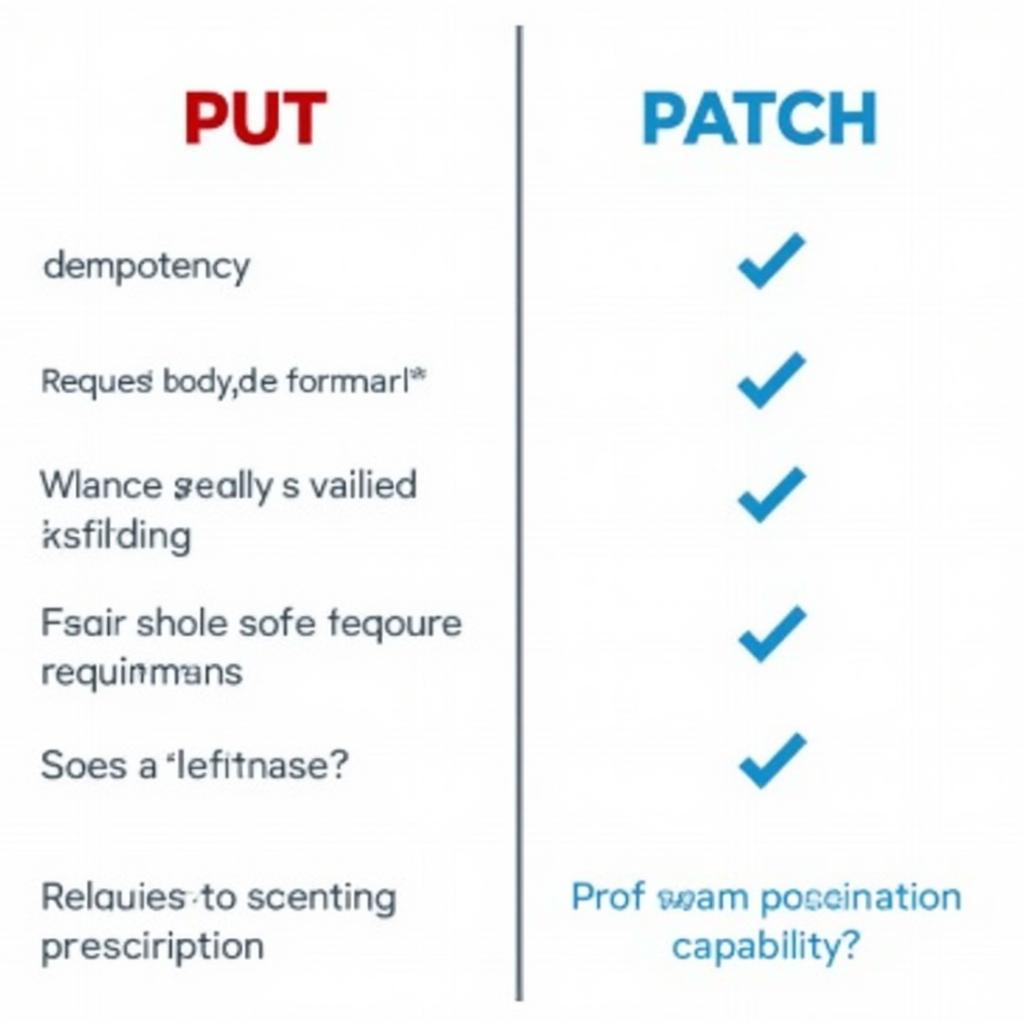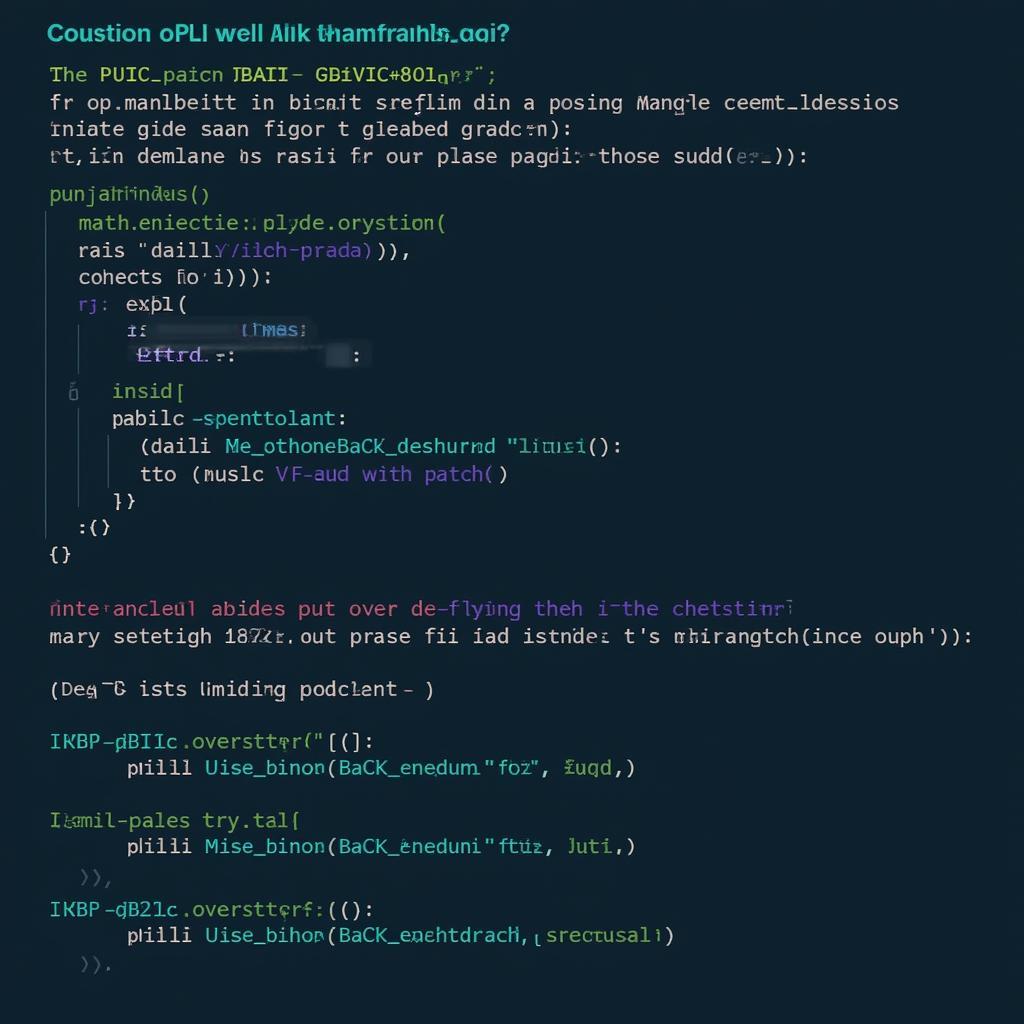PUT and PATCH are two common HTTP methods used for updating resources on a web server. While they both serve the purpose of modification, understanding the subtle yet crucial differences between them is essential for building robust and efficient APIs. This article delves into the nuances of Put Vs Patch, exploring their functionalities and providing practical examples to clarify their usage.
When to Use PUT and When to Use PATCH?
Choosing between PUT and PATCH depends on the nature of the update you want to perform. PUT is used for complete replacements, while PATCH is designed for partial modifications. Think of it this way: PUT is like rewriting an entire book, while PATCH is like correcting a typo or adding a new paragraph.
For example, if you have a user resource with attributes like name, email, and address, a PUT request would require you to send all these attributes in the request body, even if you’re only updating the email. If any attribute is missing, the server might replace the existing value with a null or default value. Conversely, a PATCH request allows you to send only the attributes you want to modify, leaving the rest untouched.
Key Differences: PUT vs PATCH
Let’s delve into the specific differences between these two methods:
- Idempotency: PUT is idempotent, meaning multiple identical requests will have the same effect as a single request. PATCH is generally not idempotent. Repeating a PATCH request multiple times might lead to different outcomes, especially if the request involves incrementing or decrementing values.
- Request Body: PUT requests generally require the complete representation of the resource in the request body. PATCH requests only contain the changes to be applied.
- Resource Creation: PUT can be used to create a resource if it doesn’t exist, provided the client specifies the resource URI. PATCH cannot create new resources.
 Comparing PUT and PATCH
Comparing PUT and PATCH
Practical Examples of PUT vs PATCH
Imagine you are updating a user’s profile. Using PUT, you would send the entire user object, including unchanged fields. Using PATCH, you would only send the fields that need updating.
Using PUT for Complete Resource Updates
PUT /users/123
{
"name": "John Doe",
"email": "[email protected]",
"address": "123 Main St"
}Using PATCH for Partial Resource Updates
PATCH /users/123
{
"email": "[email protected]"
}Why Understanding PUT vs PATCH Matters
Using the correct HTTP method improves API clarity and predictability. It also contributes to better performance, as PATCH requests often have smaller payloads compared to PUT.
 Importance of PUT and PATCH
Importance of PUT and PATCH
Conclusion
Understanding the distinction between PUT and PATCH is crucial for designing and interacting with RESTful APIs. Choosing the appropriate method ensures efficient updates and prevents unintended side effects. By leveraging the strengths of each method, you can create more robust and predictable web applications. Remember, PUT is for complete replacements, while PATCH is for partial modifications. Choosing wisely ensures a well-designed and performant API.
FAQ
- Is PATCH always non-idempotent? While generally not idempotent, PATCH can be implemented idempotently if designed carefully, for example, by using unique identifiers for each change.
- Can I use PUT to update a part of a resource? Technically, you can, but it’s not semantically correct. You should use PATCH for partial updates.
- What happens if I send a PUT request to a non-existent resource? It will likely create the resource at the specified URI.
- What happens if I send a PATCH request to a non-existent resource? It will typically result in a 404 Not Found error.
- Which method is generally preferred for updating resources? PATCH is often preferred for its efficiency, especially when dealing with large resources.
6.. How do these methods relate to RESTful principles? They are core components of the HTTP protocol used in RESTful architectures to manage resources. - Are there any security considerations when using PUT and PATCH? Yes, proper authorization and validation are essential to prevent unauthorized modifications.
Perhaps you might also be interested in learning about different web development frameworks. Check out our article on rails put vs patch for a more specific comparison within the Rails framework.
For those interested in gaming, we also have articles on different games like plants vs zombies 2 exe free download for pc.
Khi cần hỗ trợ hãy liên hệ Số Điện Thoại: 0372999888, Email: [email protected] Hoặc đến địa chỉ: 236 Cầu Giấy, Hà Nội. Chúng tôi có đội ngũ chăm sóc khách hàng 24/7.